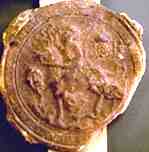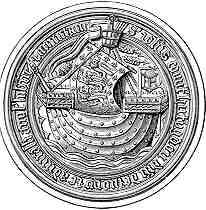



If you are looking at this page without frames, there is more information about medieval writing to be found by going to the home page (framed) or the site map (no frames).
| Seals of Particular Authority | |||
| Any corporate body or officer who was empowered to ratify legal documents employed a seal for the purpose. These might range from the grandest of high authority to simple seals of local officials. In general, the range of motifs and designs rings the changes on those found in other categories. | |||
 |
15th century seal of the Court of the King's Bench, obverse. | ||
| The special seals of the courts of law were really a variant on the royal seal, indicating the ultimate source of their authority. Henry VI sits crowned in majesty with orb and sceptre in this example. | |||
 |
Obverse and reverse of a 16th century seal of the Court of Augmentations (Nottinghamshire Archives, DDFJ 10/7/31, on a lease renewal). By permission of the Nottinghamshire Archives. |  |
|
 |
Seal of Earl John Holland, 1436. | ||
| The device on this seal indicates the position and authority of its owner as Admiral of England. The ship image combined with the use of heraldry on the sail makes it very similar to the town seals of significant ports like Hastings. | |||
| Seal of Adam, treasurer of Nevers, from 1269. (From de Boüard 1929) | |||
| This one is particularly appealing, with the treasurer hovering over and jealously guarding his treasure cupboard. It is almost an upmarket version of the seals of town tradesmen displaying their tools, but in the pointed oval shape of a person of significance. | |||
| As literate processes became more widespread for all sorts of purposes in the later middle ages, so the use of seals progressed down to lesser officials, just as the use of seals by private persons spread down the social scale. Seals of English sheriffs appeared in the early 14th century, with a variety of designs. Presumably sheriffs were also required to be able to write, as well as read the writs they were sent. By the late 14th century labourers travelling away from their homes had to carry passes sealed by someone appointed by local justices of the peace. These seals carried no graphic designs, only lettering, and were standardised. Local officials collecting customs duties for the crown had their particular seals. There seems to be some shortage of information on the range and variety of these lesser official seals. | |||
| The miscellany of seals shown on these pages, gleaned serendipidously from various sources, indicates the wealth of visual information in seals. They seem to have been studied so far in a rather classificatory way, with lots of obscure heraldic terminology. There is surely scope for an examination of these artifacts as part of social history, and as much a part of the history of literacy and the development of literate processes in society as the written words which survive on the sheets of parchment to which they are attached. | |||
|
|
|||
|
|
|||
|
If you are looking at this page without frames, there is more information about medieval writing to be found by going to the home page (framed) or the site map (no frames). |
|||